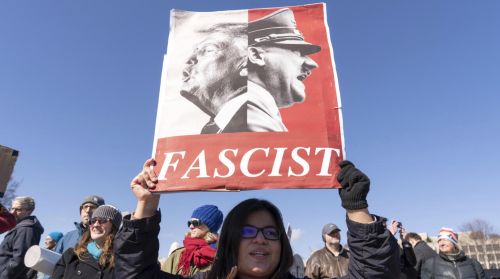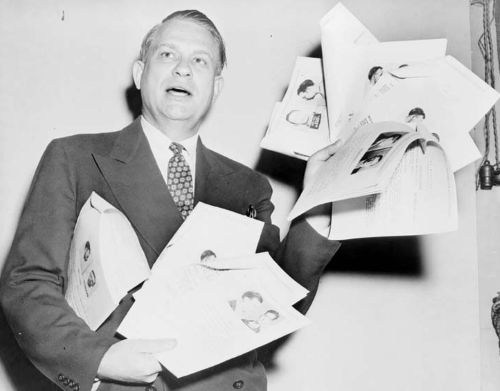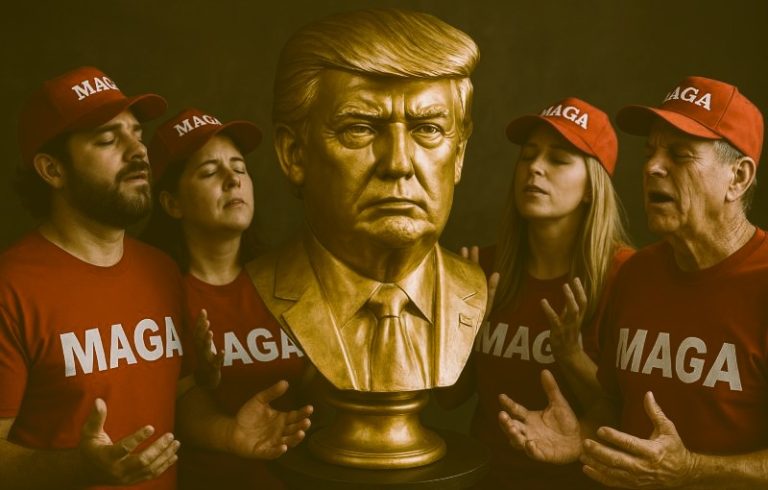

Trump’s first term set the foundation and the second pursues a reconfiguration of the republic.

By Matthew A. McIntosh
Public Historian
Brewminate
Introduction
When Donald J. Trump descended the golden escalator in Trump Tower in June 2015 to announce his candidacy for the presidency of the United States, few could have predicted the seismic shift his political ascent would cause. Yet nearly a decade later, and now into his second term as President, the political landscape has been radically altered. This transformation is not simply one of partisanship or policy, but something more insidious: the normalization of fascism within the American democratic framework.
From his first term beginning in 2017 through his second term now in progress, Trump has employed and emboldened authoritarian rhetoric, undermined democratic institutions, and encouraged a cult of personality that bears alarming similarities to the rise of fascist regimes in 20th-century Europe. While it is essential to exercise caution when drawing historical parallels, the normalization of fascistic elements in contemporary American politics under Trump is not hyperbole—it is a matter of documented fact.
The First Term: Seeds of Authoritarianism
Undermining Democratic Institutions
Trump’s first term set the foundation for a reconfiguration of American democracy. From the outset, he waged war against the free press, branding journalists “the enemy of the people”—a term with deep fascist roots. Such language not only delegitimized media scrutiny but encouraged his supporters to distrust any source of information not coming from Trump himself or right-wing outlets.
His dismissal of judicial decisions that did not align with his political goals, attacks on the FBI, Department of Justice, and intelligence agencies, and encouragement of political loyalty over constitutional duty laid a dangerous precedent. These actions mirrored tactics used by autocrats who seek to consolidate power by eroding institutional checks.
The Cult of Personality

Trump’s political movement rapidly evolved into a cult of personality. His rallies resembled quasi-religious spectacles, where loyalty to Trump was prioritized over party or policy. Symbols, slogans (“Make America Great Again”), and ritualistic chants (“Lock her up,” “Build the wall”) became cultural dogmas. The substitution of ideology with unwavering loyalty is a hallmark of fascist movements.
Militant Nationalism and Xenophobia
Trump’s immigration policies—including the Muslim Ban and family separations at the border—exemplified the scapegoating and racialization of national identity. His use of dehumanizing language like “animals,” “infestation,” and “invasion” to describe immigrants drew from fascist propaganda playbooks used to justify exclusion and violence.
The failure to unequivocally condemn white supremacist groups—culminating in the infamous “very fine people on both sides” comment after Charlottesville—gave implicit permission for far-right extremism to flourish.
Election Delegitimization and the Capitol Insurrection
Perhaps the most enduring act of democratic subversion during Trump’s first term was his refusal to concede defeat in the 2020 election. Despite no evidence of widespread fraud, Trump repeatedly insisted the election was “stolen,” a Big Lie that culminated in the violent January 6, 2021, Capitol insurrection.
This unprecedented attack on the seat of American government was incited by Trump’s own words. It was not only an assault on democratic norms but a fascistic rejection of peaceful power transfer—a foundational principle of republican governance.
The Second Term: Fascism Moves from the Margins to the Center
Revenge Governance and Institutional Purges

Upon his re-election, Trump wasted no time purging perceived enemies from federal agencies. In the first months of his second term, reports emerged of career civil servants being reassigned or terminated and replaced with partisan loyalists under the guise of “draining the deep state.” This strategy, reminiscent of Gleichschaltung in Nazi Germany, centralizes power by ensuring ideological conformity within all state organs.
Trump’s new loyalty oath initiative for federal employees, rumored to be based on Project 2025 proposals, raises serious constitutional alarms. It smacks of McCarthyist blacklisting and echoes totalitarian practices where dissent is treated as treason.
The Erosion of Judicial Independence
With several new appointments to the federal judiciary, including a potential third or even fourth Supreme Court pick, Trump’s influence over the judiciary has only grown. Judges have increasingly rendered decisions aligning with executive overreach, legitimizing controversial executive orders and bypassing congressional authority.
Trump’s administration has also flirted with the idea of ignoring or nullifying judicial rulings, a blatant violation of the separation of powers doctrine.
Weaponization of the State Against Dissent
Trump’s second term has seen a marked increase in the state being used to target political opponents. Whether through selective IRS audits, politicized DOJ investigations, or attempts to criminalize protest movements under “anti-terror” laws, the tools of governance are being turned against dissenting voices.
In a troubling echo of fascist regimes, journalists have been surveilled and activists harassed, with state law enforcement increasingly resembling a paramilitary force aligned with the executive branch.
Normalization of Violence and Militia Culture
Trump continues to encourage right-wing militia groups and has remained silent as these groups intimidate voters and activists. Phrases like “Second Amendment people” and “Stand back and stand by” have emboldened extremists who view political violence as legitimate.
The normalization of violence as a political tool is a defining feature of fascism, and under Trump’s leadership, its public acceptability has increased.
The Historical Context: Fascism Revisited
It is important to note that fascism is not a static ideology but a political method characterized by:
- Authoritarianism
- Ultranationalism
- Demonization of “the other”
- Militarization of culture
- A leader cult
- Anti-intellectualism and anti-elitism
- Suppression of dissent
Trumpism does not map perfectly onto the regimes of Mussolini or Hitler—nor should it. The American variant is more subtle, cloaked in the language of democracy while eroding its foundations. But the patterns are unmistakable. The genius of modern authoritarianism is that it often wears democratic clothing while gutting its essence.
Resistance and the Future

The normalization of fascism under Trump’s leadership has not gone unchallenged. Civil society, local governments, and some elements of the judiciary have pushed back. However, the longer these behaviors are tolerated, the more they become part of the political norm.
Educators, journalists, historians, and engaged citizens must continue to document and resist the drift toward authoritarianism. As the 20th century teaches us, democracy can erode not with a bang, but with the slow corrosion of norms and the normalization of the unacceptable.
Conclusion
Donald Trump did not invent American authoritarianism, but he has emboldened and normalized its most dangerous tendencies. From the delegitimization of elections to the weaponization of the state, Trump’s two-term presidency represents a defining case in how fascism can adapt and thrive within a democratic system. If the United States is to remain a republic rather than descend into autocracy, recognition of this transformation—and sustained resistance to it—is imperative.
Originally published by Brewminate, 05.13.2025, under the terms of a Creative Commons Attribution-NonCommercial-NoDerivatives 4.0 International license.


